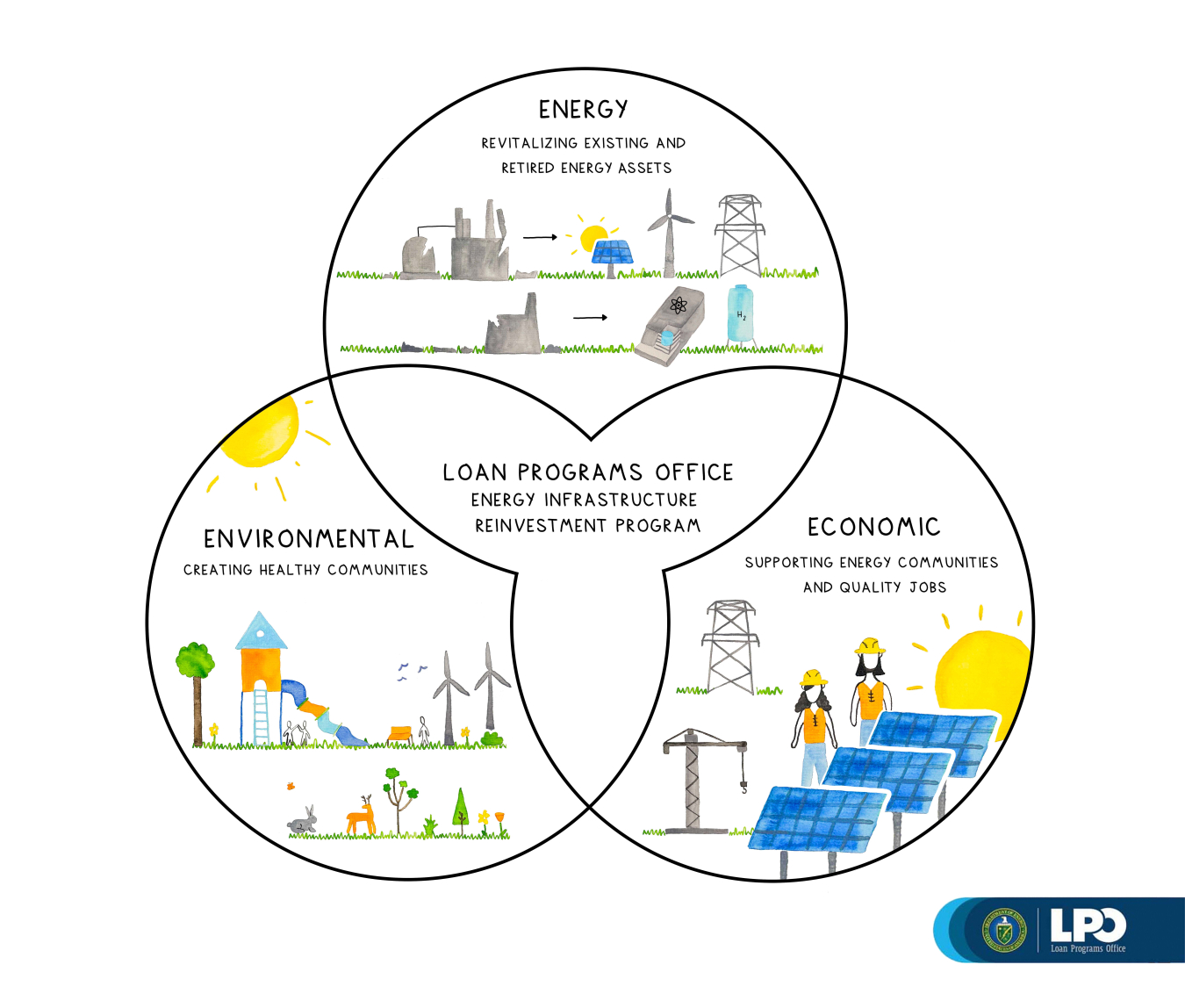Title 17 Clean Energy Financing – Energy Infrastructure Reinvestment
Financing for projects that reinvest in existing U.S. energy infrastructure for the clean energy future
Overview
Through the Energy Infrastructure Reinvestment (EIR) category of the Title 17 Clean Energy Financing Program, LPO can finance projects that retool, repower, repurpose, or replace energy infrastructure that has ceased operations or enable operating energy infrastructure to avoid, reduce, utilize or sequester air pollutants or greenhouse gas emissions. Created by the Inflation Reduction Act, EIR can help the United States leverage its extensive energy infrastructure and skilled workforce to support the energy transformation.
With EIR, LPO can support projects that reinvest in energy infrastructure throughout the United States, including in DOE-designated energy communities. Many energy communities were built around power plants, fossil fuel extraction sites, transmission and distribution systems, fossil fuel pipelines, refineries, or other energy facilities. Often, the energy infrastructure has ceased operations or continues to operate but could benefit from carbon- or pollution-reducing improvements.
The EIR project category can support a wide range of projects that utilize existing energy infrastructure and revitalize communities, including:
- Upgrading or uprating energy infrastructure so it can restart or operate more efficiently, at higher output, or with lower emissions
- Replacing retired energy infrastructure with clean energy infrastructure
- Building new facilities for clean energy purposes that utilize legacy energy infrastructure
Additionally, the scope of a project receiving EIR financing may include remediation of environmental damage associated with legacy energy infrastructure.

Defining “Energy Infrastructure”
Energy Infrastructure is defined as a facility, and associated equipment, used for (1) the generation or transmission of electric energy; or (2) the production, processing, and delivery of fossil fuels, fuels derived from petroleum, or petrochemical feedstocks.
This definition encompasses a wide variety of facilities and sites, including, but not limited to, decommissioned or operating power plants, related transmission interconnections, oil and gas infrastructure including pipelines, refineries, and gas stations or refueling terminals.
Eligibility
EIR projects are not required to be innovative but must satisfy other eligibility requirements based on the nature of the energy infrastructure and, in some instances, the type of applicant.
EIR projects qualifying under the “energy infrastructure that has ceased operations” clause must meet the following additional criteria:
- The new or updated LPO-financed infrastructure should be at or near the site of the legacy infrastructure that it retools, repowers, repurposes, or replaces. Applications that are replacing Energy Infrastructure, must show a clear relationship between new services and benefits provided by the Title 17 financed infrastructure and services, and benefits lost from the legacy infrastructure that ceased operations, such as grid capacity, reliability, and workforce retention and opportunities, including if the replacement plan differs from the legacy infrastructure physically and/or geographically.
- Projects that will invest in energy infrastructure that has ceased operations and that will generate electricity using fossil fuels must have controls or technologies to avoid, reduce, utilize, or sequester air pollutants and anthropogenic emissions of greenhouse gases.
Electric utilities that apply for an EIR loan guarantee must also demonstrate to DOE that financial benefits received from the guarantee will be passed on to the customers of, or associated communities served by, that utility.
Possible Energy Infrastructure Reinvestment Project Areas
The following is a set of project types that could be eligible for Energy Infrastructure Reinvestment financing, subject to LPO review. These examples are neither exhaustive nor limiting.
- Retired power plant (or other qualifying energy infrastructure) retooled, repowered, repurposed or replaced with:
- Renewable energy and/or storage
- Distributed energy (e.g., virtual power plant)
- Transmission interconnection to off-site clean energy
- New manufacturing facilities for clean energy products or services
- Nuclear energy
- Fossil or biomass generation with carbon capture and sequestration
- Reconductoring transmission lines and upgrading voltage
- Retrofitting of fossil-fuel power plant with carbon capture and sequestration
- Repurposing oil and gas pipelines (e.g., for H2, CO2)
- Upgrading or retrofitting refineries (e.g., for biofuels or hydrogen)
- Upgrading or uprating existing generation facilities (with emissions control technologies for projects involving fossil generation)
- Energy infrastructure repurposing for decarbonization
Additional program details and application requirements are described in the Title 17 Clean Energy Financing Program Guidance and on the Title 17 Overview web page.
Next Steps
If you have a project that may be eligible for financing through the Energy Infrastructure Reinvestment project category, please request a no-cost pre-application consultation.
